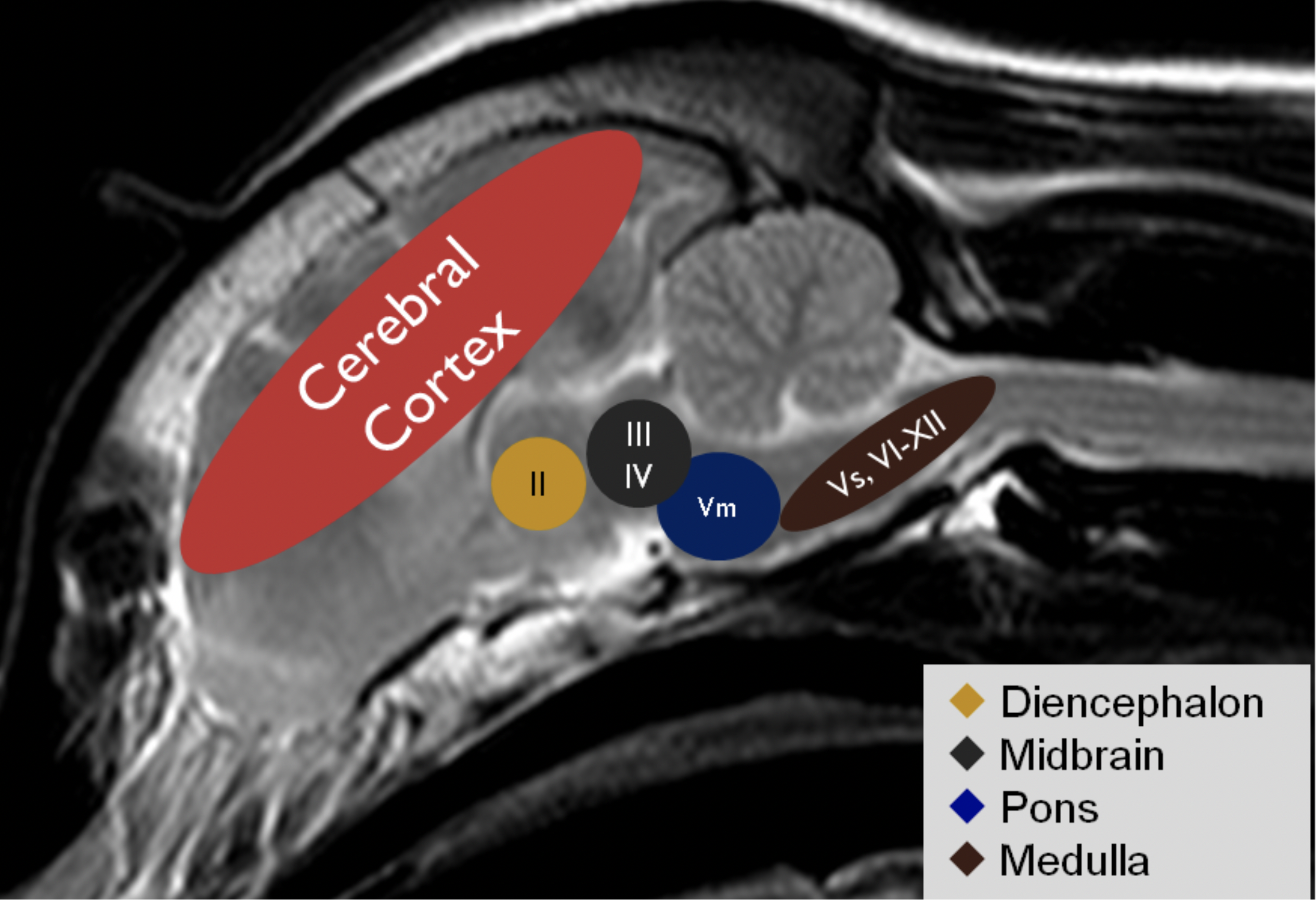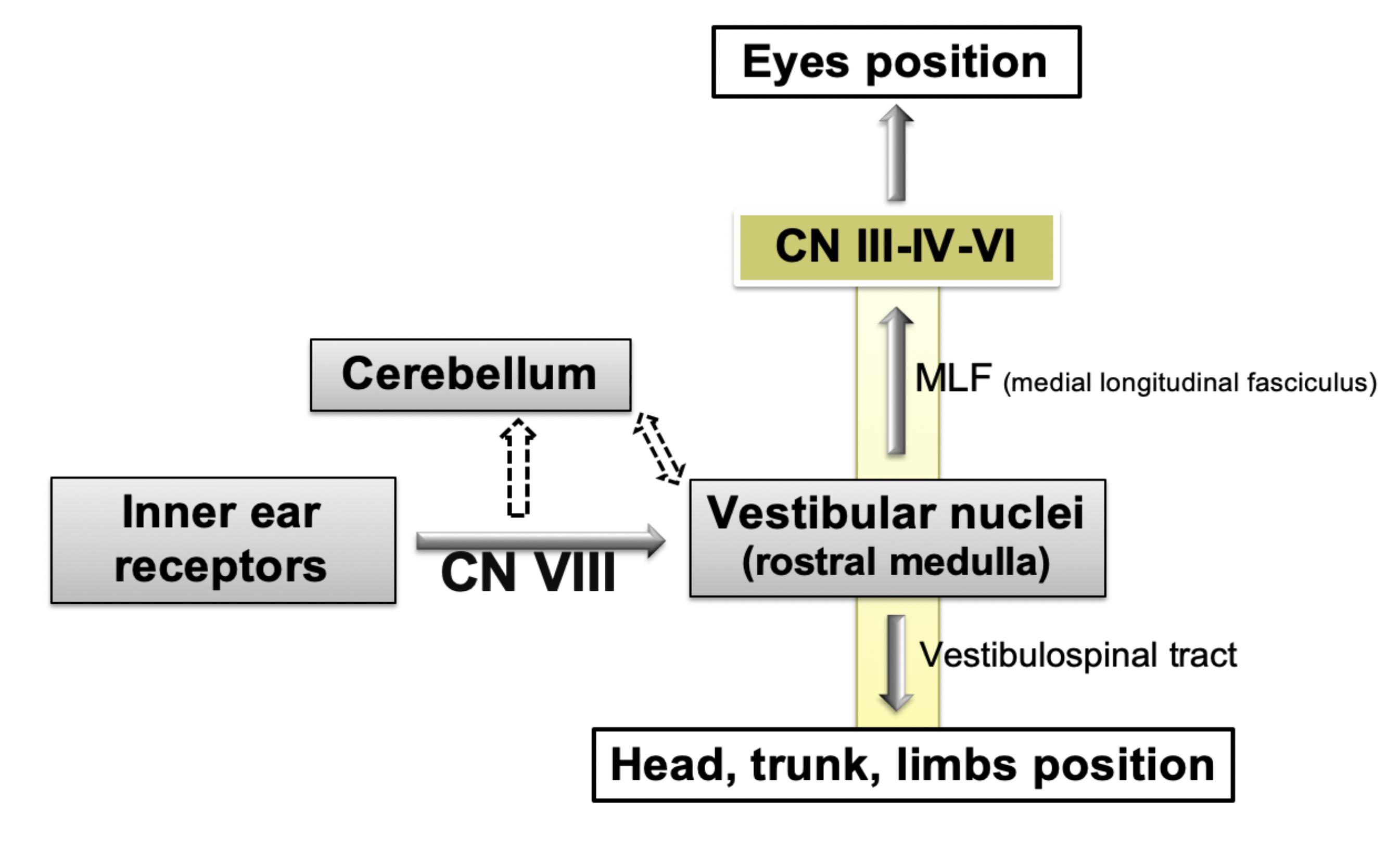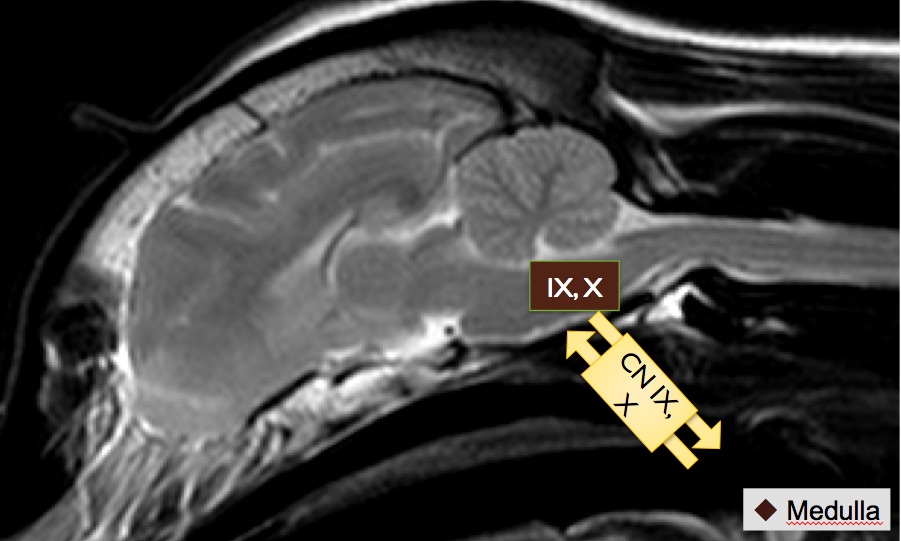Assessment of Cranial Nerves
There are 12 pairs of cranial nerves (CN I-XII):
| CRANIAL NERVE | LOCATION NUCLEI |
|---|---|
| CN I – olfactory | |
| CN II – optic | Diencephalon |
| CN III – oculomotor
CN IV – trochlear |
Midbrain |
| CN Vm – trigeminal (motor) | Pons |
| CN Vs – trigeminal (sensory)
CN VI – abducent CN VII – facial CN VIII – vestibulocochlear CN IX – glossopharyngeal CN X – vagus CN XI – accessory CN XII – hypoglossal |
Medulla |

In order to assess the function of those cranial nerves we perform 9 tests that involve the stimulation of one or more of those cranial nerves and other pathways, but CNs I and XI are not routinely evaluated. These tests are:
-
-
-
- Menace response
- Pupillary light reflexes (“PLRs”)
- Physiological nystagmus – strabismus
- Palpebral reflex
- Nasal septum sensation
- Masticatory muscles
- Facial symmetry
- Laryngeal / pharyngeal function
- Tongue function
-
-
Note: “response” implies patient’s awareness as the pathway reaches the cerebral cortex (it is cortically mediated). A “reflex” is not a conscious pathway as it is not transmitted to the cerebral cortex.
1. Menace Response:
Moving our hand towards the patient’s eye in a threatening manner should elicit a blink response (closure of the eyelid) in a normal patient. Be sure to cover the contralateral eye and not to touch the face when approaching the hand (to avoid assessing for facial sensation instead).

Pathway assessed in this the menace response test involves these components:
-
- CN II – optic (ipsilateral): afferent (=sensory)
- Thalamo-cortex (contralateral)
- Cerebellum (ipsilateral)
- Brainstem (ipsilateral)
- CN VII – facial (ipsilateral): efferent (=motor)

CN II (optic) is sensory for visual information while CN VII (facial) is motor for all facial muscles (excluding masticatory muscles). A decreased or absent menace response (lack of blinking when approaching our hand) implies lesion present in one or more of those 4 components. Dogs and cats younger than 10-12 weeks old do not have menace response.
2. Pupillary Light Reflexes (PLRs):
-
- CN II – optic (ipsilateral): afferent
- Brainstem
- CN III – oculomotor (bilateral): efferent

CN III mediates pupillary constriction. Stimulating the eye with a bright light triggers pupillary constriction in the same eye (direct PLR) and in the contralateral (consensual PLR). Pupillary size and presence of any anisocoria should be also evaluated.
3. Physiological Nystagmus – Strabismus:
-
- CN VIII – vestibulocochlear: afferent
- Brainstem: Medial longitudinal fasciculus (MLF)
- CN III (oculomotor), IV (trochlear), VI (abducent): efferent
The CN VIII (vestibulocochlear) is involved in hearing and vestibular functions (adaptation of position of the eye and body with respect to the position and movement of the head). To control the position of the eyes, the CN VIII nuclei (vestibular nuclei) in the medulla connect to the nuclei of the cranial nerves responsible for eye movement (CN III, IV, VI; innervating the extraocular muscles) via the medial longitudinal fasciculus located in the brainstem. In a normal individual, moving the head in lateral direction triggers reflex vestibular eye movements called physiological nystagmus. This nystagmus is an involuntary rhythmic movement of the eyes with a slow phase in one direction and a quick phase in the opposite direction. The direction of the nystagmus is described by that of the quick-phase movement.
Strabismus is an abnormal dorsal, ventral, medial or lateral position of the eye. It can be the result of abnormalities in CNs VIII, III, IV, or VI.

4. Palpebral Reflex:
-
- CN V – Trigeminal (sensory): sensory
- Brainstem
- CN VII – Facial: motor

CN V (trigeminal) has a sensory and a motor component. The sensory component is in charge of the sensation of the face. Touching the medial canthus of the eye (ophthalmic branch of CN V), lateral canthus of the eye (maxillary branch CN V) or the skin in front of the pinna (mandibular branch CN V) triggers a blink response.
5. Nasal Septum Sensation:

In response to stimulation of the nasal mucosa (ophthalmic branch CN V) the animal shows a conscious response pulling the head away. Both eyes should be covered during this test.
6. Masticatory Muscles:
-
- CN V – Trigeminal (motor)
The motor component of the trigeminal nerve provides innervations to the masticatory muscles (temporalis, masseter, medial and lateral pterygoid and rostral part of the digastrics muscles). By evaluating the size and symmetry of the masticatory muscles, particularly the temporalis, we can evaluate the integrity of the motor function of CN V.
7. Facial Symmetry – Ears, Eyelids, Nose, Lips:
-
- CN VII- Facial
- CN VII- Facial

Observe patient’s face for asymmetrical ear position (drooping ear), eyelid closure or widened palpebral fissure, nose and lips.
8. Laryngeal – Pharyngeal Function:
-
- CN IX- Glossopharyngeal
- CN X – Vagus

This is mostly evaluated through patient’s history. Any difficulty eating, drinking or swallowing could suggest pharyngeal dysfunction, while changes in voice (barking) could suggest laryngeal dysfunction.
9. Tongue Function:
-
- CN XII- Hypoglossal
Assessment of tongue movement and atrophy as CN XII provides motor innervations to the tongue.
Cranial Nerve Summary:
| CN test | Afferent CN | Intermediate region | Efferent CN |
|---|---|---|---|
| Menace response | CN II | Thalamo-cortex
Cerebellum Brainstem |
CN VII |
| PLRs | CN II | Brainstem | CN III |
| Nystagmus-strabismus | CN VIII | Brainstem | CN III, IV, VI |
| Palpebral reflex | CN Vs | Brainstem | CN VII |
| Nasal septum | CN Vs | Brainstem Thalamo-cortex | |
| Masticatory muscles | Brainstem | CN Vm | |
| Facial symmetry | Brainstem | CN VII | |
| Laryngeal/pharyngeal | CN IX, X | Brainstem | CN IX, X |
| Tongue function | Brainstem | CN XII |
| Cranial nerve test | Expected effect in a normal patient |
| Menace response | Blink induced by moving our hand toward the patient’s eye |
| Pupillary light reflex | Pupillary constriction elicited by a bright light in the eye |
| Nystagmus-strabismus | Physiological nystagmus when moving the head side to side |
| Palpebral reflex | Blink elicited by touching eye canthus or skin rostral to pinna |
| Nasal septum | Withdrawal of the head when touching the nasal mucosa |
| Masticatory muscles | Normal muscle size and symmetry in both sides |
| Facial symmetry | Symmetrical position ears, eyelids, nose, lips |
| Laryngeal/pharyngeal | History not reporting difficulties eating, drinking or swallowing, or voices (barking) changes |
| Tongue function | Normal range of motion and no atrophy in the tongue |

